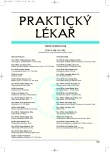Thyroid disease in the GP’s practice
Onemocnění štítné žlázy v ordinaci praktického lékaře
Tyreopatie postihují nejméně 5 % populace s věkovým nárůstem a podstatně častějším výskytem u žen. Nejčastěji jsou autoimunitního původu, z nedostatku jodu a růstu nádorů. Diagnostika zahrnuje 1) posouzení lokálního nálezu, 2) posouzení tyreoidální funkce, 3) určení etiopatogeneze a biologické povahy.
Základem je anamnéza a klinické vyšetření, z pomocných metod funkčního vyšetření je nejdůležitější stanovení TSH (tyreotropního hormonu), FT4 (volného tyroxinu), FT3 (volného trijodotyroninu). K posouzení lokálního nálezu je nejdůležitější ultrasonografie, k průkazu autoimunity stanovení tyreoidálních protilátek (proti peroxidáze, tyreoglobulinu a TSH receptoru). Cytologické vyšetfiení je jediným spolehlivým průkazem malignity, vyšetření tyreoglobulinu je cenné pro sledování léčby nádorů.
Základní principy léčby jsou propracované, ověřené a dostupné, přitom je nutno přihlížet k povaze choroby, věku nemocného, polymorbiditě a její medikamentozní léčbě. Zvláštní péči vyžaduje léčba v graviditě. Většinu tyreopatií je možno léčit ambulantně. Spolupráce endokrinologa a praktického lékaře je nezbytným předpokladem úspěšné diagnostiky a léčby tyreopatií.
Klíčová slova:
štítná žláza, diagnostika, terapie, hypertyreóza, tyreotoxikóza, struma, tyreoiditida.
Authors:
V. Zamrazil 1,2
Authors‘ workplace:
Endokrinologický ústav Praha
Ředitel: doc. MUDr. Vojtěch Hainer, CSc.
1; Subkatedra endokrinologie IPVZ, Praha
Vedoucí: prof. MUDr. Václav Zamrazil, DrSc.
2
Published in:
Prakt. Lék. 2007; 87(3): 142-149
Category:
Various Specialization
Overview
Thyroid disease affects at least 5 % of the general population. The incidence is higher in females and rises with increasing age. Thyroid disorders are most commonly of autoimmune origin or due to iodine deficiency or tumorous growth.
Diagnosis involves 1) evaluation of the local findings, 2) evaluation of the thyroid function, 3) identification of the aetiology and biological nature.
Diagnosis should be first established on the basis of the patient’s history and physical examination. TSH (Thyroid-stimulating hormone), fT4 (free thyroxin) and fT3 (free triiodthyronine) are the most important indicators of thyroid function. Ultrasonography provides substantial local anatomic information, thyroid autoantibodies (to thyroperoxidase, thyreoglobulin and the TSH receptor) are useful markers of autoimmunity. Fine-needle aspiration biopsy is the only reliable method to document malignancy. Thyroglobulin can be used as marker in the cancer treatment follow-up.
The standard treatment procedures are well defined and have been proven in clinical practice, however due care must be given to the nature of the disease, the age of the patient, concomitant diseases and treatments. Treatment of thyroid disorders during pregnancy presents a special problem. The majority of thyroid diseases can be treated in the outpatient clinic. Cooperation between endocrinologist and general practitioner is essential for the successful diagnosis and treatment of thyroid diseases.
Key words:
thyroid gland, diagnostics, therapy, hypothyroidism, thyrotoxicosis, goitre, thyroiditis.
Labels
General practitioner for children and adolescents General practitioner for adultsArticle was published in
General Practitioner

2007 Issue 3
- Memantine in Dementia Therapy – Current Findings and Possible Future Applications
- Metamizole vs. Tramadol in Postoperative Analgesia
- Metamizole at a Glance and in Practice – Effective Non-Opioid Analgesic for All Ages
- Memantine Eases Daily Life for Patients and Caregivers
- What Effect Can Be Expected from Limosilactobacillus reuteri in Mucositis and Peri-Implantitis?
Most read in this issue
- Testosterone replacement therapy in aging men.
- Drug-induced gynecomastia
- ACTH-dependent Cushing’s syndrome due to a carcinoid tumour Cushing’s
- Thyroid cancer and malignant lymphoma – is there a relationship?
